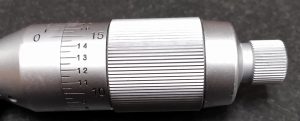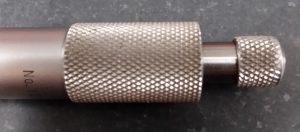Table of Contents
ToggleWhat is knurling?
Knurling is the process of creating a pattern on a workpiece to improve the visual appearance or to create a better grip on the part. Knurling uses the tool to displace material. This moving of the workpiece material creates the knurled pattern. A great example of knurling is seen on the thimble of most micrometers. Knurling is also often used on various knobs to provide grip.
Types of knurling


There are four main types of knurling. These are straight knurling, diamond knurling, left hand and right hand knurling. Of these different knurling types, straight and diamond are by far the most commonly used. There are many variations of these patterns including fine, medium, and coarse versions of each. Fine knurling has the lowest profile whereas coarse knurling would have prominent ridges to provide greater friction for gripping.
Cut knurling vs form knurling
Cut and form knurling are the two methods of creating knurling.
Form knurling is the standard form of knurling. Form knurling is pressing the knurling tool into the workpiece to create the raised grooves or teeth.
Cut knurling scrapes away material instead to create the knurling pattern. Cut knurling is better for some materials such as plastic or Delrin.
Does knurling increase diameter?
Form knurling does increase the diameter of the workpiece. This happens because the knurling tool is displacing material (moving it) which pushes material in in some locations and out in others. The amount of increase depends upon whether the knurling is fine or coarse. Coarse knurling has more material displaced and therefore creates bigger valleys and mountains in the workpiece.
Cut knurling decreases the diameter of the workpiece. This occurs because material is removed from the part instead of moved around like in form knurling.
Can you knurl wood?
Yes, wood can be knurled but it is not as simple as knurling metal. Knurling really only works for hard woods in the same way as metal. However, a simple pattern can be created through a process called checkering.
Can you knurl plastic?
Plastics can be knurled though usually in a different way. Cut knurling is often used instead of standard form knurling.
Can you knurl Delrin?
Yes, you can knurl acetal plastic, also known as Delrin. It will be more difficult than knurling metal but if you manage you speeds, feeds, and depth of cut carefully then you can come out with something that looks nice and is functional. Cut knurling is a good choice for Delrin.
Knurling tips
Do your knurling before your final finishing. Knurling applies pressure to the workpiece and can bend it.
Because the force on the workpiece is so big, make sure that everything is secure including the part and the cutter.
Multiple passes frequently yield the best results
Thoughts?
Got any knurling tips? Share them and we will add them to the list.